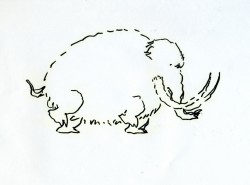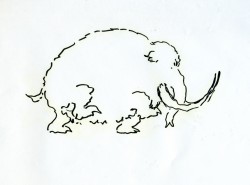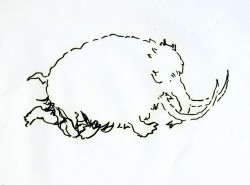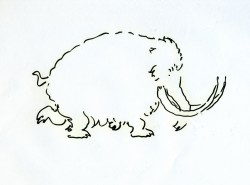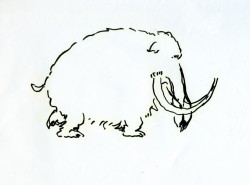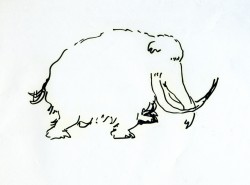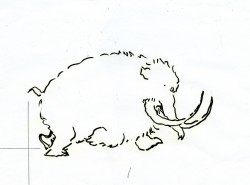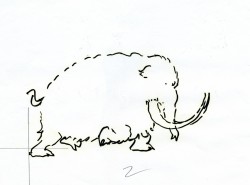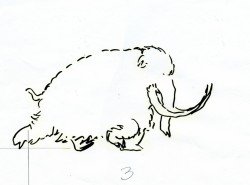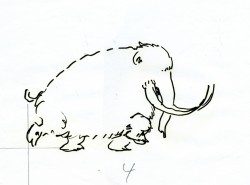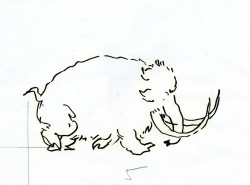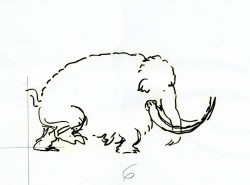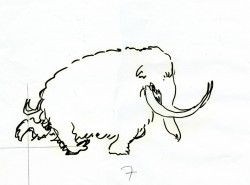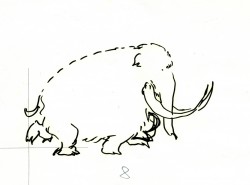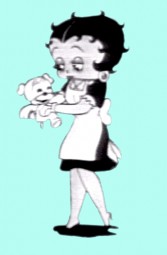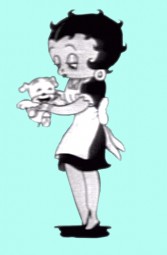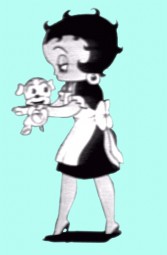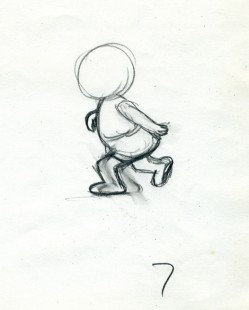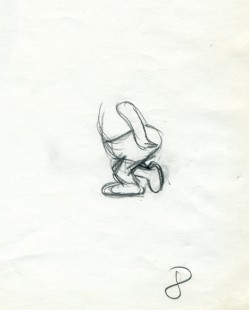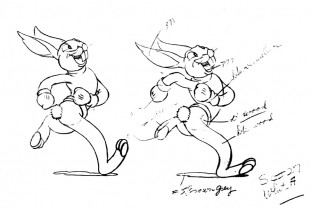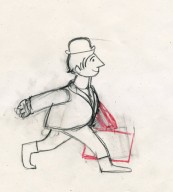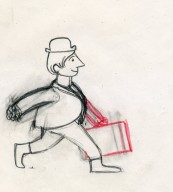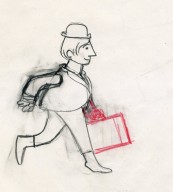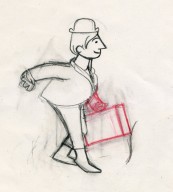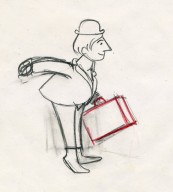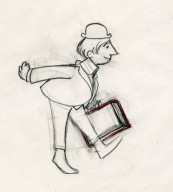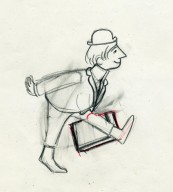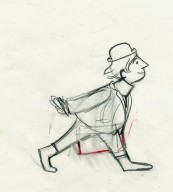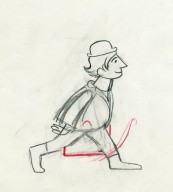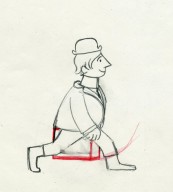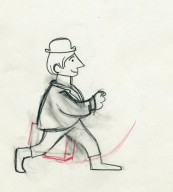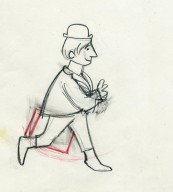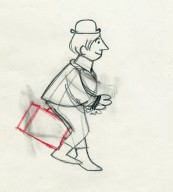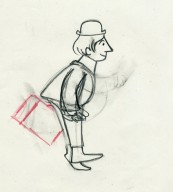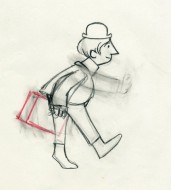Category Archivewalk cycle
Animation &Commentary &Fleischer &Frame Grabs &walk cycle 10 Mar 2008 08:12 am
Betty Walks Backwards
Thad Komorowski posts a Popeye cartoon Popeye Meets William Tell which he surmises that Shamus Culhane is the director (he receives top animation billing under Dave Fleischer’s name.) The only other animator listed is Al Eugster. The cartoon is certainly an oddity, and I’m glad Thad highlighted it for me. It looks like an afterthought from the Gulliver’s Travels team. I don’t remember seeing it before, though I must have. It’s not that great a Popeye short; just an odd one.
There’s a curious thing happening in a walk in the opening of that film, and I hoped I had the film somewhere so that I could take a better look at it frame by frame. I don’t have it so will have to wait until I receive vol.2 of the Popeye dvd.
However I started looking a little closer at some Fleischer shorts. There are no end of interesting walks in those films. I found in the last Betty short Rhythm On the Reservation, that Betty walks backwards through about 1/3 of the film. She’s supposed to be conducting a beat for the Native Americans she’s visiting. What comes out is an interesting cycle that was probably animated by Myron Waldman.
I thought I’d share this walk with you.
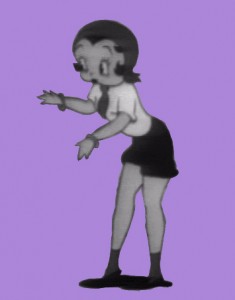 1
1 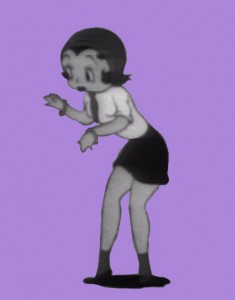 2
2 (Click any image to enlarge.) Betty walks backwards keeping time on three’s.
I can’t help but note that the Fleischer walks always seem to include
a complete turn of the head from left to right.
All animation is exaggeration.
Animation &Tissa David &walk cycle 12 Dec 2007 08:37 am
Tissa Elephant
- Before I get into the post for today, I wanted to call attention to a brand new site dedicated to Richard Williams‘ film The Cobbler and the Thief.
The site, called The Thief, is a collaboration of four artists who worked on the film, but they’re encouraging conversation from others who were involved. It looks to be a promising site.

Thanks to Matt Jones for directing me to it. (By the way, check out Matt’s site if you aren’t familiar with it.)
- Here are the drawings for a walk cycle Tissa David animated for an elephant walking in a well-played Perrier commercial from the 80′s. It was a spot done for the Ink Tank in R.O. Blechman ‘s style. These are rough drawings.
Tissa did two versions of the walk in ruff. I’m posting both here so you can see the difference she got in the walks. The second one, which is the final, is subtlety. It’s a quieter walk and is more apporpriate to the tone of the spot. (That’s back when animation didn’t have to jump from pose to pose and could actually move properly.) I’ve added a QT version of each of the walks to view the movement.
The first RUFF version follows:
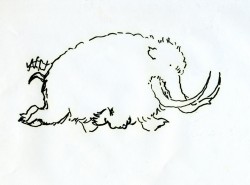 1
1 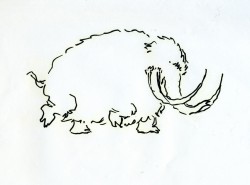 2
2
Click on the drawings to enlarge.
The version used for the final follows.
You’ll note the crosses on each drawing. One might assume this is for re-registering the drawings, but that’s not the case. (You’d need at least three crosses for a fair registration.)
Tissa usually draws a horizon line for each foot of the walker. In the case of these drawings, she drew only the line for the back two legs.
When teaching people how to draw a walk, she starts by drawing two parallel lines and informing you that each line is for one of the feet of the character. The two feet (four in an animal) should NOT be on the same line. It helps to give a slight feeling of depth to the body.
I can’t tell you how many walks I’ve seen lately that don’t even follow this simple and basic rule.
If you go here, you’ll see another spot Tissa and Blechman did for Perrier from the same campaign.
Animation &Fleischer &walk cycle 21 Nov 2007 09:13 am
Betty Walks
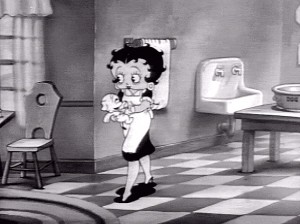 – Back when I wanted to become an animator, there was always the same statement by the hardened professionals: it takes ten years to become a decent animator. I always wondered what happened in that ninth year. I wondered if you could do it sooner. Ward Kimball and Myron Waldman were considered boy wonders who quickly rose to the top of their respective studios. Not only did they become animators; the became directing animators.
– Back when I wanted to become an animator, there was always the same statement by the hardened professionals: it takes ten years to become a decent animator. I always wondered what happened in that ninth year. I wondered if you could do it sooner. Ward Kimball and Myron Waldman were considered boy wonders who quickly rose to the top of their respective studios. Not only did they become animators; the became directing animators.
Nowadays, all you have to do is register with Flash, and you’re an animator.
As I entered the business, it became obvious that the walk cycle was the make or break point for an animator. You had to be able to master the walk cycle and be able to do something interesting with it – something interesting that helped define the character. (Although, Adam Elliot did boast that he’d never done a walk cycle in all of his films including the half-hour Harvie Krumpet which won the Oscar.)
However, even in Flash you often have to make characters walk. That’s why I’ve put a lot of focus on walk cycles, lately. The Fleischer films seem to have created cycles that are more manageable, so it’s easy to focus on them. Here’s a cycle of Betty from the short, A Little Soap and Water (1935). I’m pretty sure it’s Myron Waldman‘s work. It’s not really a cycle, but I’ve maneuvered into one for viewing.
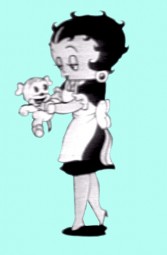 1
1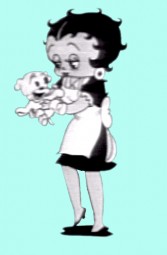 2
2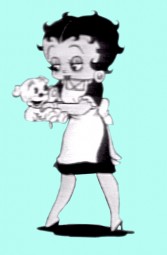 3
3
____(Click any image to enlarge.)
Animation &Animation Artifacts &Hubley &Tissa David &walk cycle 14 Aug 2007 07:56 am
Georgia walk
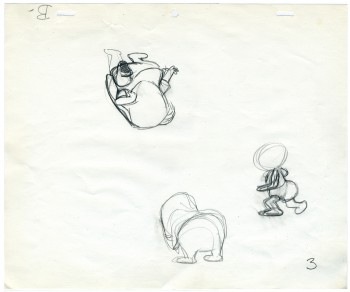 – Finishing up posts featuring artwork from John & Faith Hubley’s Cockaboody, I have this walk cycle from Tissa David.
– Finishing up posts featuring artwork from John & Faith Hubley’s Cockaboody, I have this walk cycle from Tissa David.
Tissa is careful not to use too much paper. Hence she reuses old paper for her very rough preliminaries as she figures out her animation.
It’s frequent, when visiting her work space, to see lots of pages featuring char-acters on both sides of the paper upside down as well as sideways. She doesn’t often let these rough roughs out of her hands before she throws them out. I guess I was there at the right time and talked her into giving me these drawings.
She animates the walk, here, on top pegs bacause that’s all she has left of space. Tissa nomally works on bottom pegs. Actually, since this is going to be a sliding cel, it would have been done top pegs anyway.
Georgia, the younger girl, leaves the bathroom and moves to the floor to play with a doll (whose head she accidentally pulls off).
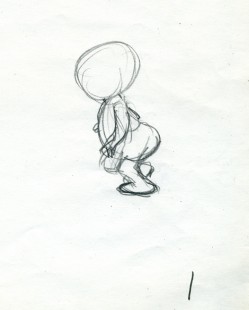 1
1 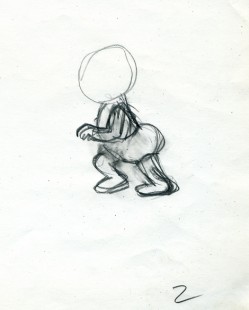 2
2
(click any image to enlarge.)
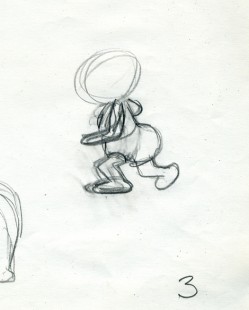 3
3 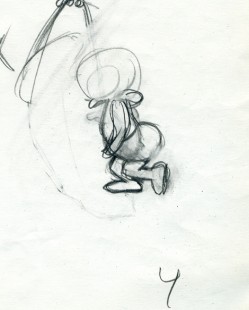 4
4
The walk is heavy and a bit flatfooted. She doesn’t come down on her toes but plants the entire foot.
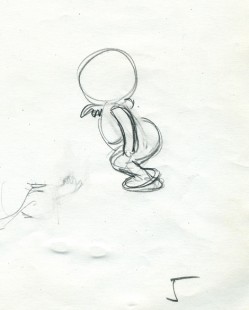 5
5 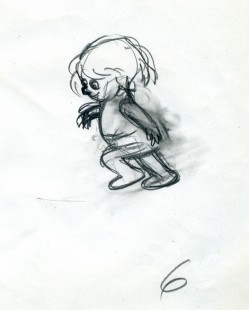 6
6
Her arms are high because, a baby, she’s still a bit off balance.
Animation &Animation Artifacts &walk cycle 01 Mar 2007 08:13 am
Max Hare
- Just to catch a breath of fresh air, I’ve decided to post this great run cycle of Max Hare from Disney’s 1935 Silly Symphony, The Tortoise and the Hare. I think it was Ham Luske who animated him; he did the bulk of the Hare in this film.
All drawings move from left to right. ![]()
(All drawings enlarge by clicking.)
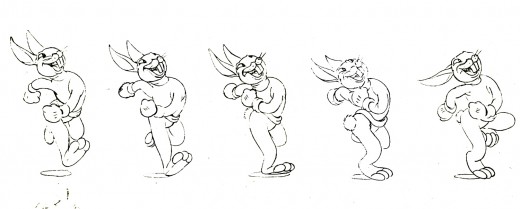
There’s a graceful beauty in this cycle. He saunters, more than runs. The tempo for it seems to be a basic 120, your average everyday walk cycle. I’d have to go back to the actual film to be sure.
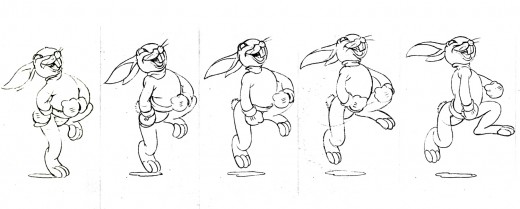
It’s interesting that he’s off the ground for 5 out of every 12 drawings. It helps create a delicate buoyancy overall. This is feasibly impossible, but it makes the run richer.
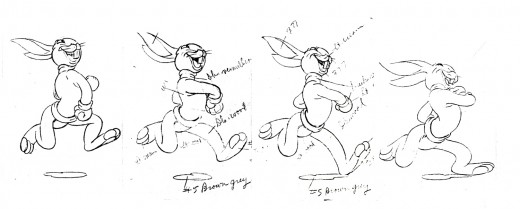
The arm movements tell you a lot about the character. He’s full of himself and moves his entire upper torso with the arm movements. He’s definitely showing off.
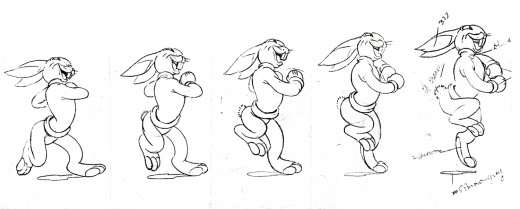
Mike Barrier has a good piece in his book, Hollywood Cartoons: American Animation in Its Golden Age, on Ham Luske’s animation of Max Hare. It’s reprinted on line here.
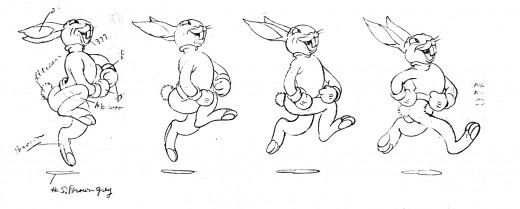
A number of the drawings have been marked up for color inking, and others have been marked for color painting.
Animation Artifacts &walk cycle 21 Feb 2007 07:54 am
He’s Got Strings
- Hans Perk, on his site A Film LA, has been posting the complete set of Drafts for Pinocchio, and after my post of the Jiminy Cricket run last week, I feel compelled to give more from this great Disney film.
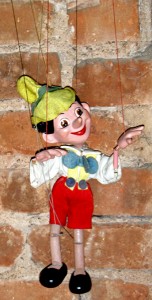 I have this walk – Pinocchio with strings, as operated by Gepetto from above. It’s one of the most complex problems I can imagine, and I think you have to be something of a genius animator to pull it off. Needless to say, Frank Thomas did. He mastered all the challenges of the weight of the object to allow you to completely disbelieve you were watching drawings move, yet you were able to get into the mind of the puppeteer.
I have this walk – Pinocchio with strings, as operated by Gepetto from above. It’s one of the most complex problems I can imagine, and I think you have to be something of a genius animator to pull it off. Needless to say, Frank Thomas did. He mastered all the challenges of the weight of the object to allow you to completely disbelieve you were watching drawings move, yet you were able to get into the mind of the puppeteer.
It’s a brilliant piece of acting. A lifeless creature given life through Gepetto’s manipulation. The scene, of course, contrasts with the “Got No Strings” number where Pinocchio dances among puppets that are manipulated by the professional puppeteer, Stromboli, as opposed to the non-professional, Gepetto. It’s so complex yet done so well that it looks simple.
The drafts list this film as Prod. F3, but the drawings are labelled as F5. I’m not sure what else F5 could stand for since it’s certainly not the seq or sc number. Confusion on my part.
Here they are. Enlarge all images by clicking them.
![]() Note that the drawings read from Right to Left:
Note that the drawings read from Right to Left:
.
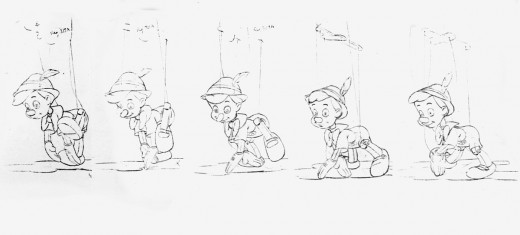
I love Pinocchio’s hand grazing the ground as he’s moved forward. The thrust of his body is all in the head, butt and upper back, as are most marionettes. The strings are an extension of the puppeteer’s hands.
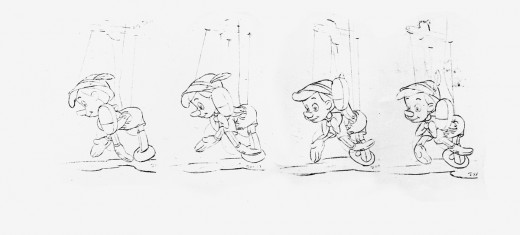
As the foot moves around the rest of the puppet is spun around, too. It’s a beautiful and graceful turn.
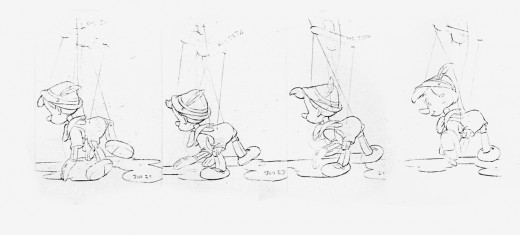
His foot slaps down, and again the hand touches the ground as the puppet prepares to be lifted forward by the offscreen control demands in the play against gravity.
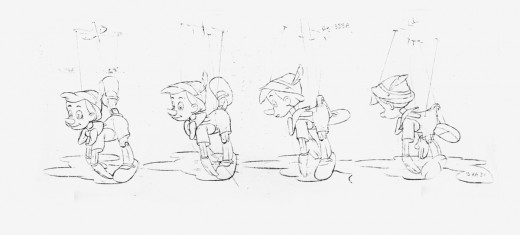
As the back leg goes up and around, the smiling face comes back around to us. Pinocchio’s butt is up there with that foot. A great puppeteer wouldn’t have Pinocchio bent over in this walk, as we see later in Stromboli’s characters.
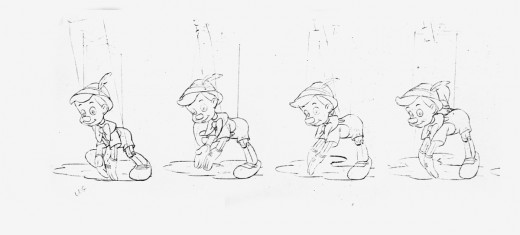
Finally, Pinocchio comes back to the starting point as if this were a normal walk cycle. What a gem of a piece. There were brilliant animators going at it at that studio. Technically, this can be done by some of today’s 2D animators, but I wonder if the meat of the scene would be as good.
Animation Artifacts &Hubley &Tissa David &walk cycle 10 Oct 2006 07:55 am
Upkeep Cycles
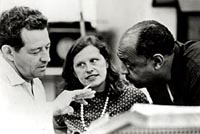 – Back in 1973, the Hubleys produced Upkeep, a short film for IBM. It chronicled the history of the service repairman in a light hearted way. Actually an industrial, it was treated like a personal film. (There’s a thin line between some of their industrials and their personal films.) Of Men and Demons was done for IBM though they considered it a personal film; it instructed in the positive aspects of the binary code and was nominated for an Oscar.
– Back in 1973, the Hubleys produced Upkeep, a short film for IBM. It chronicled the history of the service repairman in a light hearted way. Actually an industrial, it was treated like a personal film. (There’s a thin line between some of their industrials and their personal films.) Of Men and Demons was done for IBM though they considered it a personal film; it instructed in the positive aspects of the binary code and was nominated for an Oscar.
(John & Faith Hubley with
composer, Benny Carter)
Tissa David did the lion’s share of the animation for Upkeep. Phil Duncan, Lu Guarnier and Jack Schnerk were the other key animators on it. Helen Komar and I assisted all of them, and I inked the whole film. Gen Hirsch and I colored it. John did all the Bg’s.
The initial animation on the service man was done by Phil Duncan. Tissa had to pick up the character, and she found the walk Phil had done so funny that she kept it throughout the film adding shades and tones to it as she thought appropriate.
The art was inked with a sharpie, bled with thinner, then colored with magic markers. Each drawing was then cut out and pasted to cels. Hubley’s Bg’s followed the same style: sharpie on board, washed & bled with thinner, added watercolor washes.
Posted below are the drawings for that 18 drawing walk cycle.
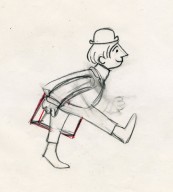
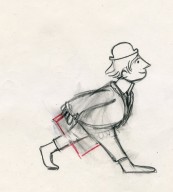
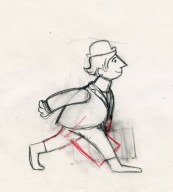
(Click any image to enlarge them.)
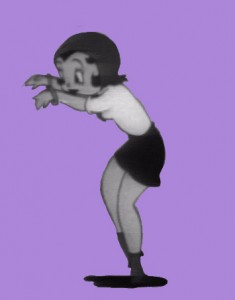 3
3 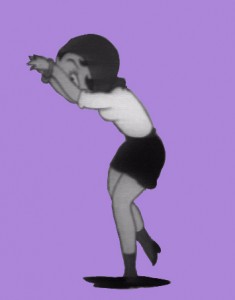 4
4 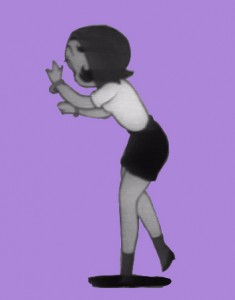 5
5 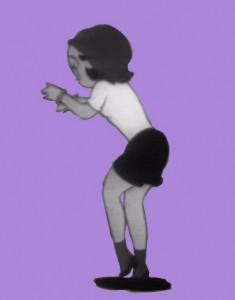 6
6 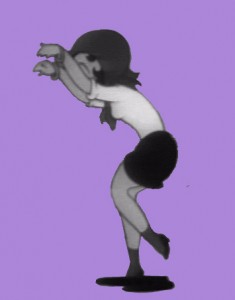 7
7 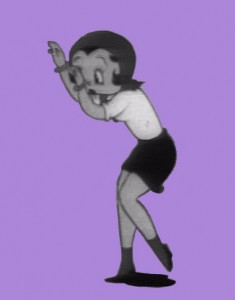 8
8 